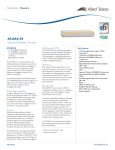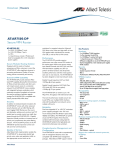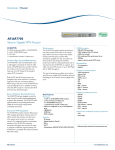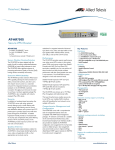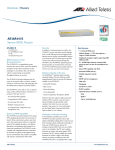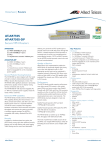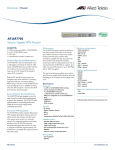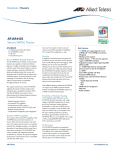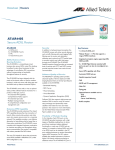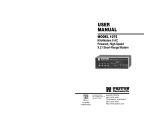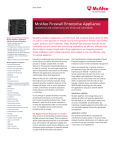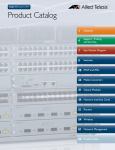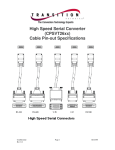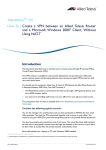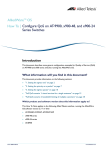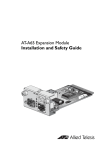Download Allied Telesis AT-AR415S-50
Transcript
Datasheet | Routers AT-AR415S Secure Modular Router AT-AR415S 1 x 10/100BASE-T WAN port 4 x 10/100BASE-T LAN ports 1 x asynchronous port 1 x PIC bay Integrated Security Engine The AT-AR415S is a secure modular router offering performance, flexibility and security for small to medium-sized business. Packaged in a compact one-rack unit chassis, this versatile router provides five 10/100 Fast Ethernet interfaces and supports a variety of Port Interface Cards (PICs). For the WAN network, the AT-AR415S features one 10/100Mbps Ethernet Port. Also offered is an asynchronous port, and four Layer 2 switched LAN ports–any of which can also be reconfigured as a DMZ. Simple Plug-in flexibility A range of different PICs can be plugged into the PIC bay, including high speed E1/T1,V35/V21 sync and BRI/PRI ISDN, allowing a high degree of flexibility and a wide choice of WAN connectivity.The onboard management/async port can be used for local management or for connection to an external modem. Security Allied Telesis’ high performance Stateful Inspection Firewall significantly enhances the overall security of business critical information. The AT-AR415S delivers up to 100 Mbps of firewall throughput, and on board hardware encryption offers DES, 3DES and AES (Advanced Encryption Standard) hardware encryption, that uses up to 256 bit key code. The AT-AR415S also has integrated hardware Virtual Private Network (VPN) acceleration delivering up to 95 Mbps of 3DES VPN + NAT and firewall throughput and up to 80 Mbps of AES-256 VPN + NAT and firewall throughput1. Allied Telesis AES-Encrypted VPN The AT-AR415S secure modular router supports the Advanced Encryption Standard (AES). AES is a Federal Information Processing Standard (FIPS 197) that specifies a cryptographic algorithm for use by U.S. Government organizations to protect sensitive, unclassified information. VPN IPsec IPsec (Internet Protocol Security) is a set of protocols for security at the network or packet processing layer. Early approaches to security were performed at the application layer of the communications model. IPsec is critical for secure virtual private networks and for remote user access through dial-up connections to private networks. 802.1Q VLAN The AT-AR415S security router is 802.1Q compliant.This enables the user to configure up to 64 VLANs with VLAN Identifier numbers (VID) between one and 4,094. Key Features • 1 PIC bay supporting a range of WAN connections • 1 Ethernet 10/100Mbps WAN port • 4 Ethernet 10/100Mbps LAN ports • 1 Async port (RJ45) • Stateful Inspection Firewall • AES, 3DES, DES hardware based encryption • MD5 / SHA • Up to 50 VPN tunnels2 • L2TP • Supports Windows XP, 2000 VPN clients that use pre-shared keys and X509 Certificates • PPPoE • Protection against Denial of Service attacks • SSH / SSL • 802.1x • SMTP and HTTP proxy • RADIUS / TACAS+ look-up • PAP / CHAP user authentication • RoHS compliant The 802.1Q specification establishes a standard method for inserting VLAN membership information into Ethernet frames. VLANs can span many switches.VLANs between switches are achieved by inserting a tag with a VID between one and 4,094 into each frame. A VID must be assigned for each VLAN. By assigning the same VID to VLANs on many switches, one or more VLANs (broadcast domains) can be extended across a large network. The AT-AR415S can firewall between VLANs thus providing protection within the network from internal attacks. 1 Performance numbers subject to change. 2 Additional licensing required. www.alliedtelesis.com AT-AR415S | Secure Modular Router Firewall Allied Telesis’ high performance Stateful Inspection Firewall provides a high level of security by supplying full application-layer awareness without breaking the client/server model. Allied Telesis’ Stateful Inspection Firewall: • Offers per packet dynamic access control (Stateful Inspection) for all traffic reaching the firewall • Protects against a wide range of Denial of Service (DOS) attacks, including Ping of Death, Smurf attacks, port scans, fragment attacks and IP Spoofing • Sends automatic email alerts to initiate appropriate action Software Quality of Service The AlliedWareTM operating system provides advanced Quality of Service (QoS) and traffic shaping features.There are five key QoS features available on the AT-AR415S: • Bandwidth Metering • RED Curves • Mixed Scheduling • Virtual Bandwidth • Dynamic Application Recognition (DAR) Software QoS also supports eight queues per interface. DAR is used to snoop for session setup exchanges and dynamically create classifiers that match the voice and video packets in the session. For more information, see the Allied Telesis Advanced QoS White Paper available on our website. Triggered Events and Scripts A trigger sets off an ordered sequence of scripts and router commands to be executed when a certain event occurs.This is a powerful mechanism for automating the execution of router commands in response to specific events. Each trigger may reference multiple scripts and any script can be used by any trigger. Using this feature, the AT-AR415S can, for example, send an email alert to the network manager when trouble occurs, or can automatically shut down an interface to protect against suspected attacks. The scripting facility enables sequences of commands to be stored in a script and replayed at any time, allowing the AT-AR415S to be easily configured or quickly re-configured.This is useful when developing a complex configuration, making the same configuration change to several different routers, Layer 3 switches or security appliances, or introducing a configuration change that must occur at a particular time. Scripts can be created on a PC Allied Telesis and uploaded to the router, or they can be created using the router's own integrated text editor. They can be activated either from the command line or from a trigger. Hardware Features • 1 x 10/100Mbps Ethernet WAN port • 4 x 10/100Mbps Ethernet LAN ports • 1 x asynchronous port (RJ45) World Class Operating System • 1 x PIC bay The AT-AR415S is shipped ‘ready to run’ with AlliedWare, a comprehensive software suite that includes all the features, management capabilities and performance that today’s networks demand. • 802.1q tagged VLANs, with support for up to any 64 VLAN IDs of a possible 4094 (LAN ports only) • Automatic MDI/MDI-X crossover with user override via software commands (LAN ports only) AlliedWare is Allied Telesis’ feature rich operating system (OS) that serves as the foundation for its entire line of Layer 3 routers and switches. Robust and reliable, the AlliedWare OS offers a breadth of functionality for any application. • 266MHz CPU • 32MB SDRAM • 16MB of Flash memory enabling storage of 2 software releases • On-board hardware security processor enabling the following advanced encryption function: AlliedWare also delivers a high level of flexibility and investment protection. AlliedWare is a common OS, so the AT-AR415S secure modular router is able to interoperate seamlessly with other Allied Telesis security appliances and Layer 3 switches. As a standardsbased implementation, AlliedWare also assures full interoperability with all other major network equipment vendors. - Complete processing of IPsec header and trailer - Support for 3DES, DES, DES-MAC, AES, SHA-1 and MD-5 - PKI acceleration for Diffie-Hellman, RSA and DSA - D-H negotiation (with 1024-bit modulus, 180-bit exponent) - 1024-bit sign and verify RSA and DSA Feature licenses give access to a set of progressive features: Real Time Clock • The Advanced Layer 3 Upgrade provides a set of cutting edge protocols such as IPv6, BGP-4 and Server Load Balancing. • The Firewall Licensing Upgrade can increase the concurrent firewall sessions from 2000 to 4000 or 8000. • VPN Licensing Upgrades allow for the base unit with a single VPN tunnel to be upgraded to 5, 10, 25 or 50 concurrent users. The real time clock (RTC) keeps track of current date and time. During times when the system has been powered down, a backup battery supplies power to the RTC. Port Interface Cards AT-AR020 Single configurable E1/T1 interface that supports channelized/unchannelized Primary Rate ISDN/Frame Relay AT-AR021S (V3)4 Single Basic Rate ISDN (S/T) interface AT-AR023 Single Synchronous port up to 2Mbps to an external CSU/DSU (ATV.35-DTE-00 or AT-X.21DTE-00 cable required) • PPP over Ethernet configuration and monitoring AT-AR024 Four Asynchronous RS232 interfaces to 115Kbps • DHCP server configuration and monitoring AT-AR027 Two VoIP FXS ports Graphical User Interface The AT-AR415S’ Graphical User Interface (GUI) allows for swift, pain free configuration and management. The following major features are incorporated in the AT-AR415S GUI: • Easy configuration for connection to the Internet • Firewall configuration and monitoring, ability to view events, logs and device status 3 • IPsec configuration 3 • Site-to-site and Remote Access VPN wizards Available in AlliedWare 2.9.1 4 AR021S (V3) requires AlliedWare® Operating System version 2.9.1-13 or later www.alliedtelesis.com AT-AR415S | Secure Modular Router Software Features Environmental Specifications • • • • • • • • • • • • • • • • • • • • • • • • • Operating temperature range: 0oC to 40oC (32oF to 104oF) Storage temperature range: -25oC to 70oC (-13oF to 158oF) Relative humidity range: 5 to 95% non-condensing • • • • • • • • • • • Secure VPN option IPsec (AES, 3DES, DES, DES-MAC, MD5, SHA-1) Stateful Inspection Firewall Network Address Translation (NAT) CLI, PAP and CHAP RADIUS,TACACS PKI for IKE/IPsec SSL SecureShell remote management UPnP v1.0 Generic Routing Encapsulation Dynamic IP address assignment L2TP (Layer 2 Tunneling Protocol) DHCP PPPoE IP packet filtering IP multihoming Demand IP and IPX IPX/SPX spoofing Spanning tree on Bridge Ports BAP/BACP (Bandwidth Allocation Protocol) PPP multilink Callback IP/IPX and bridge filtering Advanced routing protocols OSPF, BGP-4, RIP and RIPv2 Multicast protocols DVMRP, PIM-SM, PIM-DM SNMP management v2c and SNMPv3 GUI OSI Server Load Balancer IPv6 IP, IPX routing RSVP VRRP IP Packet prioritization STAC data compression (s/w only) Reliability System MTBF: PSU MTBF: Base MTBF: 90,000 hours min 150,000 hours min 533,000 hours min Standards and Protocols Software Release 2.9.1 BGP-4 RFC 1771 Border Gateway Protocol 4 RFC 1966 BGP Route Reflection RFC 1997 BGP Communities Attribute RFC 1998 Multi-home Routing RFC 2385 Protection of BGP Sessions via the TCP MD5 Signature Option RFC 2439 BGP Route Flap Damping RFC 2858 Multiprotocol Extensions for BGP-4 RFC 2918 Route Refresh Capability for BGP-4 RFC 3065 Autonomous System Confederations for BGP RFC 3392 Capabilities Advertisement with BGP-4 Encryption RFC 1321 MD5 RFC 2104 HMAC RFC 2451 The ESP CBC-Mode Cipher Algorithms FIPS 46-3 DES FIPS 46-3 3DES FIPS 180 SHA-1 FIPS 186 RSA FIPS 197 AES FIPS 140-2 Compliant Ethernet RFC 894 Ethernet II Encapsulation IEEE 802.1D MAC Bridges IEEE 802.1G Remote MAC Bridging IEEE 802.1Q Virtual LANs IEEE 802.2 Logical Link Control IEEE 802.3ac VLAN TAG IEEE 802.3u 100BASE-T IEEE 802.3x Full Duplex Operation Frame Relay RFC 1490, 2427 Multiprotocol Interconnect over Frame Relay ANSI T1S1 Frame relay Power Characteristics 100 to 240vAC, 50 to 60Hz Physical Dimensions 1U rack mount (with included kit), Depth 190mm, Width 305mm (440mm width with the included rack mount kit fitted) Weight 1.75 kg (3.75lbs) Regulatory Approvals EMC Emissions: EN55022 class A, FCC class A, VCCI class A, AS/NZS CISPR22 class A Immunity: EN55024 Safety: UL60950, CAN/CSA-C22.2NO. 6095000, EN60950 Listing: UL, cUL,TUV Allied Telesis General Routing RFC 768 UDP RFC 791 IP RFC 792 ICMP RFC 793 TCP RFC 826 ARP RFC 903 Reverse ARP RFC 925 Multi-LAN ARP RFC 950 Subnetting, ICMP RFC 1027 Proxy ARP RFC 1035 DNS RFC 1055 SLIP RFC 1122 Internet Host Requirements RFC 1144 Van Jacobson's Compression RFC 1256 ICMP Router Discovery Messages RFC 1288 Finger RFC 1332 The PPP Internet Protocol Control Protocol (IPCP) RFC 1334 PPP Authentication Protocols RFC 1377 The PPP OSI Network Layer Control Protocol (OSINLCP) RFC 1518 CIDR RFC 1519 CIDR RFC 1542 BootP RFC 1552 The PPP Internetworking Packet Exchange Control Protocol (IPXCP) RFC 1570 PPP LCP Extensions RFC 1582 RIP on Demand Circuits RFC 1598 PPP in X.25 RFC 1618 PPP over ISDN RFC 1661 The Point-to-Point Protocol (PPP) RFC 1662 PPP in HDLC-like Framing RFC 1701 GRE RFC 1702 GRE over IPv4 RFC 1812 Router Requirements RFC 1877 PPP Internet Protocol Control Protocol Extensions for Name Server Addresses RFC 1918 IP Addressing RFC 1962 The PPP Compression Control Protocol (CCP) RFC 1968 The PPP Encryption Control Protocol (ECP) RFC 1974 PPP Stac LZS Compression Protocol RFC 1978 PPP Predictor Compression Protocol RFC 1989 PPP Link Quality Monitoring RFC 1990 The PPP Multilink Protocol (MP) RFC 1994 PPP Challenge Handshake Authentication Protocol (CHAP) RFC 2131 DHCP RFC 2125 The PPP Bandwidth Allocation Protocol (BAP) / The PPP Bandwidth Allocation Control Protocol (BACP) RFC 2390 Inverse Address Resolution Protocol RFC 2516 A Method for Transmitting PPP Over Ethernet (PPPoE) RFC 2661 L2TP RFC 2822 Internet Message Format RFC 2878 PPP Bridging Control Protocol (BCP) RFC 3022 Traditional NAT RFC 3046 DHCP Relay Agent Information Option RFC 3232 Assigned Numbers RFC 3993 Subscriber-ID Suboption for DHCP Relay Agent Option "IPX Router Specification", v1.2, Novell, Inc., Part Number 107-000029-001 ISO 10589, ISO 10589 Technical Corrigendums 1, 2, 3, ISO Intermediate System-to-Intermediate System ISO 8473, relevant parts of ISO 8348(X.213), ISO 8343/ Add2, ISO 8648, ISO 8648, ISO TR 9577 Open System Interconnection ISO 9542 End System to Intermediate System Protocol draft-ietf-ipsec-nat-t-ike-08.txt Negotiation of NATTraversal in the IKE draft-ietf-ipsec-udp-encaps-08.txt UDP Encapsulation of IPsec Packets http://www.iana.org/assignments/bootp-dhcp-parameters BootP and DHCP parameters IP Multicasting RFC 1075 DVMRP RFC 1112 Host Extensions RFC 2236 IGMPv2 RFC 2362 PIM-SM RFC 2715 Interoperability Rules for Multicast Routing Protocols RFC 3973 PIM-DM draft-ietf-idmr-dvmrp-v3-9 DVMRP www.alliedtelesis.com AT-AR415S | Secure Modular Router IPsec RFC 1828 RFC 1829 RFC 2395 RFC 2401 RFC 2402 RFC 2403 RFC 2404 RFC 2405 RFC 2406 RFC 2407 RFC 2408 RFC 2409 RFC 2410 RFC 2411 RFC 2412 RFC 3173 IP Authentication using Keyed MD5 IPsec algorithm IPsec Compression - LZS Security Architecture for IP AH - IP Authentication Header IPsec Authentication - MD5 IPsec Authentication - SHA-1 IPsec Encryption - DES ESP - IPsec encryption IPsec DOI ISAKMP IKE IPsec encryption - NULL IP Security Document Roadmap OAKLEY IPComp - IPsec compression IPv6 RFC 1981 Path MTU Discovery for IPv6 RFC 2080 RIPng for IPv6 RFC 2365 Administratively Scoped IP Multicast RFC 2375 IPv6 Multicast Address Assignments RFC 2460 IPv6 RFC 2461 Neighbour Discovery for IPv6 RFC 2462 IPv6 Stateless Address Autoconfiguration RFC 2463 ICMPv6 RFC 2464 Transmission of IPv6 Packets over Ethernet Networks RFC 2465 Allocation Guidelines for Ipv6 Multicast Addresses Management Information Base for IP Version 6: Textual Conventions and General Group RFC 2466 Management Information Base for IP Version 6: ICMPv6 Group RFC 2472 IPv6 over PPP RFC 2526 Reserved IPv6 Subnet Anycast Addresses RFC 2529 Transmission of IPv6 over IPv4 Domains without Explicit Tunnels RFC 2710 Multicast Listener Discovery (MLD) for IPv6 RFC 2711 IPv6 Router Alert Option RFC 2851 Textual Conventions for Internet Network Addresses RFC 2893 Transition Mechanisms for IPv6 Hosts and Routers RFC 3056 Connection of IPv6 Domains via IPv4 Clouds RFC 3307 Allocation Guidelines for IPv6 Multicast Addresses RFC 3315 DHCPv6 RFC 3484 Default Address Selection for IPv6 RFC 3513 IPv6 Addressing Architecture RFC 3587 IPv6 Global Unicast Address Format RFC 3596 DNS Extensions to support IPv6 RFC 3810 Multicast Listener Discovery Version 2 (MLDv2) for IPv6 ISDN ANSI T1.231-1997 Digital Hierarchy - Layer 1 In-Service Digital Transmission Performance Monitoring Standardization ANSI T1.403-1995 Telecommunications - Network-toCustomer Installation - DS1 Metallic Interface ANSI T1.408-1990 ISDN Primary Rate - Customer Installation Metallic Interfaces, Layer 1 Specification AT&T TR 54016-1989 Requirements for Interfacing Digital Terminal Equipment to Services Employing the Extended Superframe Format Austel TS 013.1:1990 General Requirements for Customer Equipment Connected to ISDN Basic Rate Allied Telesis Access - Vol. I: Customer Equipment Access Interface Specifications Bellcore SR-3887 1997 National ISDN Primary Rate Interface ETS 300 012:1992 Integrated Services Digital Network (ISDN); Basic user-network interface; Layer 1 specification and test principles ETS 300 102-1:1990 Integrated Services Digital Network (ISDN);User-network interface layer 3;Specifications for basic call control ETS 300 102-2:1990 Integrated Services Digital Network (ISDN); User-network interface layer 3; Specifications for basic call control; Specification Description Language (SDL) diagrams ETS 300 125:1991 Integrated Services Digital Network (ISDN); User-network interface data link layer specification; Application of CCITT Recommendations Q.920/I.440 and Q.921/I.441 ETS 300 153:1992 Integrated Services Digital Network (ISDN);Attachment requirements for terminal equipment to connect to an ISDN using ISDN basic access (Candidate NET 3 Part 1) ETS 300 156:1992 Integrated Services Digital Network (ISDN); Attachment requirements for terminal equipment to connect to an ISDN using ISDN primary rate access (Candidate NET 5) ETS 300 011:1992 Integrated Services Digital Network (ISDN); Primary rate user-network interface; Layer 1 specification and test principles G.706 (1988) Frame Alignment and CRC Procedures Relating to Basic Frame Structures Defined in G.704 G.794 (1988) Characteristics of 24-channel transmultiplexing equipments German Monopol (BAPT 221) Type Approval Specification for Radio Equipment for Tagging and Identification I.120 (1988) Integrated services digital networks (ISDNs) I.121 (1988) Broadband aspects of ISDN I.411 (1988) ISDN user-network interface reference configurations I.430 (1988) Basic user-network interface - Layer 1 specification I.431 (1988) Primary rate user-network interface Physical layer specification ITU-T G.703 Physical/electrical characteristics of hierarchical digital interfaces ITU-T G.704 Synchronous frame structures used at 1544, 6312, 2048, 8488 and 44736 kbit/s hierarchical levels ITU-T G.706 Frame Alignment and CRC Procedures Relating to Basic Frame Structures Defined in G.704 ITU-T Q.922 ISDN data link layer specification for frame mode bearer services ITU-T G.703 (1972) Physical/electrical characteristics of hierarchical digital interfaces Japan NTT I.430-a Leased Line Basic Rate User-Network Interface Layer 1-Specification New Zealand Telecom TNA 134 Telecom ISDN UserNetwork Interface: Layer 3: PART B Basic Call Control Procedures Q.920 (1988) Digital subscriber Signalling System No.1 (DSS1) - ISDN user-network interface data link layer General aspects Q.921 (1988) ISDN user-network interface - Data link layer specification Q.930 (1988) Digital subscriber Signalling System No. 1 (DSS 1) - ISDN user-network interface layer 3 - General aspects Q.931 (1988) Digital subscriber Signalling System No. 1 (DSS 1) - ISDN user-network interface layer 3 specification for basic call control Rockwell Bt8370 Fully Intergrated T1/E1 Framer and Line Interface data sheet Technical Reference of Frame Relay Interface, Ver. 1, November 1993, Nippon Telegraph and Telephone Corporation. Ver. 1, November 1993, Nippon Telegraph and Telephone Corporation. ACA TS 013.2:1990 General Requirements for Customer Equipment Connected to ISDN Basic Rate Access, Vol 2: Conformance Testing Specifications ACA TS 014.1:1990 General Requirements for Customer Equipment Connected to ISDN Primary Rate Access, Vol 1: Customer Access Interface Specifications ACA TS 014.2:1990 General Requirements for Customer Equipment Connected to ISDN Primary Rate Access, Vol 2: Conformance Testing Specifications Management RFC 1155 MIB RFC 1157 SNMP RFC 1212 Concise MIB definitions RFC 1213 MIB-II RFC 1493 Bridge MIB RFC 1643 Ethernet MIB RFC 1657 Definitions of Managed Objects for BGP-4 using SMIv2 RFC 2011 SNMPv2 MIB for IP using SMIv2 RFC 2012 SNMPv2 MIB for TCP using SMIv2 RFC 2096 IP Forwarding Table MIB RFC 2576 Coexistence between V1, V2, and V3 of the Internet-standard Network Management Framework RFC 2578 Structure of Management Information Version 2 (SMIv2) RFC 2579 Textual Conventions for SMIv2 RFC 2580 Conformance Statements for SMIv2 RFC 2665 Definitions of Managed Objects for the Ethernet-like Interface Types RFC 2674 Definitions of Managed Objects for Bridges with Traffic Classes, Multicast Filtering and Virtual LAN Extensions (VLAN) RFC 2790 Host MIB RFC 2819 RMON (groups 1,2,3 and 9) RFC 2856 Textual Conventions for Additional High Capacity Data Types RFC 2863 The Interfaces Group MIB RFC 3164 Syslog Protocol RFC 3289 Management Information Base for the Differentiated Services Architecture CDP RFC 3410 Introduction and Applicability Statements for Internet-Standard Management Framework RFC 3411 An Architecture for Describing SNMP Management Frameworks RFC 3412 Message Processing and Dispatching for the SNMP RFC 3413 SNMP Applications RFC 3414 User-based Security Model (USM) for SNMPv3 RFC 3415 View-based Access Control Model (VACM) for the SNMP RFC 3416 Version 2 of the Protocol Operations for SNMP RFC 3417 Transport Mappings for the SNMP RFC 3418 MIB for SNMP RFC 3636 Definitions of Managed Objects for IEEE 802.3 MAUs RFC 3768 VRRP www.alliedtelesis.com AT-AR415S | Secure Modular Router draft-ietf-bridge-8021x-00.txt Port Access Control MIB IEEE 802.1AB LLDP OSPF RFC 1245 RFC 1246 RFC 1586 RFC 1793 RFC 2328 RFC 3101 OSPF protocol analysis Experience with the OSPF protocol OSPF over Frame Relay Extending OSPF to Support Demand Circuits OSPFv2 The OSPF Not-So-Stubby Area (NSSA) Option Quality of Service RFC 2205 Reservation Protocol RFC 2211 Controlled-Load RFC 2474 DCSP in the IPv4 and IPv6 Headers RFC 2475 An Architecture for Differentiated Services RFC 2597 Assured Forwarding PHB Group RFC 2697 A Single Rate Three Color Marker RFC 2698 A Two Rate Three Color Marker RFC 3246 An Expedited Forwarding PHB (Per-Hop Behavior) IEEE 802.1p Priority Tagging RIP RFC 1058 RIPv1 RFC 2082 RIP-2 MD5 Authentication RFC 2453 RIPv2 Security RFC 959 FTP RFC 1413 IDP RFC 1492 TACACS RFC 1779 X.500 String Representation of Distinguished Names. RFC 1858 Fragmentation RFC 2284 EAP RFC 2510 PKI X.509 Certificate Management Protocols RFC 2511 X.509 Certificate Request Message Format RFC 2559 PKI X.509 LDAPv2 RFC 2585 PKI X.509 Operational Protocols RFC 2587 PKI X.509 LDAPv2 Schema RFC 2865 RADIUS RFC 2866 RADIUS Accounting RFC 3280 X.509 Certificate and CRL profile draft-grant-tacacs-02.txt TACACS+ Draft-IETF-PKIX-CMP-Transport-Protocols-01 Transport Protocols for CMP draft-ylonen-ssh-protocol-00.txt SSH Remote Login Protocol IEEE 802.1x Port Based Network Access Control PKCS #10 Certificate Request Syntax Standard Diffie-Hellman Services RFC 854 Telnet Protocol Specification RFC 855 Telnet Option Specifications RFC 856 Telnet Binary Transmission RFC 857 Telnet Echo Option RFC 858 Telnet Suppress Go Ahead Option RFC 932 Subnetwork addressing scheme RFC 951 BootP RFC 1091 Telnet terminal-type option RFC 1179 Line printer daemon protocol RFC 1305 NTPv3 RFC 1350 TFTP RFC 1510 Network Authentication RFC 1542 Clarifications and Extensions for the Bootstrap Protocol Allied Telesis RFC RFC RFC RFC RFC RFC RFC 1945 1985 2049 2068 2156 2217 2821 HTTP/1.0 SMTP Service Extension MIME HTTP/1.1 MIXER Telnet Com Port Control Option SMTP SSL RFC 2246 The TLS Protocol Version 1.0 draft-freier-ssl-version3-02.txt SSLv3 VoIP RFC 2543 SIP G.711 A/µ law Pulse code modulation (PCM) of voice frequencies G.723.1 Dual rate speech coder for multimedia communications transmitting at 5.3 and 6.3 kbit/s G.729 A/B (Optional) Coding of speech at 8 kbit/s using conjugate-structure algebraic-code-excited linear-prediction (CS-ACELP) H.323 v2 Packet-based multimedia communications systems Firewall licensing options AT-FL-18B 4000 session firewall license Order number: 980-000046 AT-FL-18C 8000 session firewall license Order number: 980-000047 VPN licensing options AT-FL-19B 5 concurrent VPN sessions Order number: 980-000094 AT-FL-19C 10 concurrent VPN sessions Order number: 980-000095 AT-FL-19D 25 concurrent VPN sessions Order number: 980-000096 AT-FL-19E X.25 RFC 1356 Multiprotocol Interconnect on X.25 and ISDN in the Packet Mode ITU-T Recommendations X.25 (1988), X.121 (1988). X.25 Ordering Information 50 concurrent VPN sessions Order number: 980-000097 Hardware upgrade options Port Interface Cards AT-AR020 Order number: 990-11847-xx Single configurable E1/T1 interface that supports channelized/unchannelized Primary Rate ISDN/Frame Relay Order Number: 990-001304-00 Where xx = AT-AR021S (V3)4 AT-AR415S-xx 10 20 30 40 50 for for for for for U.S. power cord no power cord U.K. power cord Australia power cord Europe power cord The AT-AR415S ships with a rack mount kit. Optional wall mount kit Single Basic Rate ISDN (S/T) interface Order Number: 990-002153-00 AT-AR023 Single Synchronous port up to 2Mbps to an external CSU/DSU (AT-V.35-DTE-00 or AT-X.21-DTE-00 cable required) Order number: 990-001104-00 Order number: 990-11009-00 AT-AR024 Software upgrade options Four Asynchronous RS232 interfaces to 115Kbps Order number: 990-001105-00 AT-AR400 – ADVL3UPGRD AR400 Series Advanced Layer 3 Upgrade • IPv6 • BGP-4 • Server Load Balancing Order number: 980-10021-00 AT-AR027 Two VoIP FXS ports Order number: 990-001356-00 4 AT-FL-15 WAN Load Balancer (feature license) Order number: 980-000038 AR021S (V3) requires AlliedWare® Operating System version 2.9.1-13 or later www.alliedtelesis.com AT-AR415S | Secure Modular Router About Allied Telesis Allied Telesis is part of the Allied Telesis Group. Founded in 1987, the company is a global provider of secure Ethernet/IP access solutions and an industry leader in the deployment of IP Triple Play networks over copper and fiber access infrastructure. Our POTS-to-10G iMAP integrated Multiservice Access Platform and iMG intelligent Multiservice Gateways, in conjunction with advanced switching, routing and WDM-based transport solutions, enable public and private network operators and service providers of all sizes to deploy scalable, carrier-grade networks for the cost-effective delivery of packet-based voice, video and data services.Visit us online at www.alliedtelesis.com. Service and Support Allied Telesis provides value-added support services for its customers under its Net.Cover programs. For more information on Net.Cover support programs available in your area, contact your Allied Telesis sales representative or visit our website: www.alliedtelesis.com USA Headquarters | 19800 North Creek Parkway | Suite 100 | Bothell | WA 98011 | USA | T: +1 800 424 4284 | F: +1 425 481 3895 European Headquarters | Via Motta 24 | 6830 Chiasso | Switzerland | T: +41 91 69769.00 | F: +41 91 69769.11 Asia-Pacific Headquarters | 11 Tai Seng Link | Singapore | 534182 | T: +65 6383 3832 | F: +65 6383 3830 www.alliedtelesis.com © 2010 Allied Telesis Inc. All rights reserved. Information in this document is subject to change without notice. All company names, logos, and product designs that are trademarks or registered trademarks are the property of their respective owners. 617-000146 Rev H






